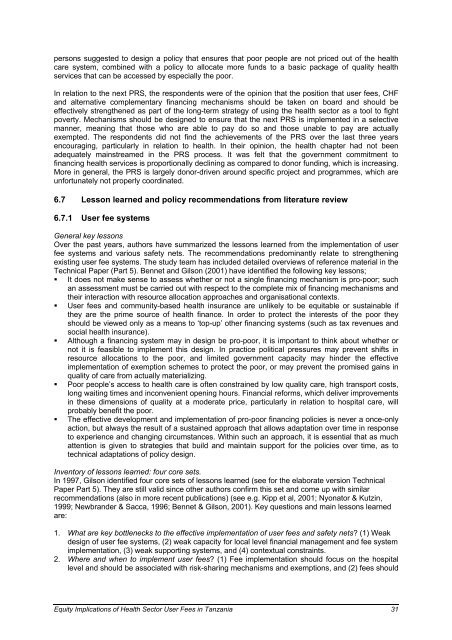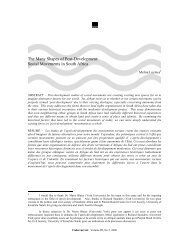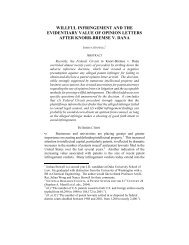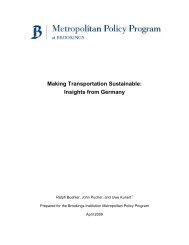equity implications of health sector user fees in tanzania
equity implications of health sector user fees in tanzania
equity implications of health sector user fees in tanzania
You also want an ePaper? Increase the reach of your titles
YUMPU automatically turns print PDFs into web optimized ePapers that Google loves.
persons suggested to design a policy that ensures that poor people are not priced out <strong>of</strong> the <strong>health</strong><br />
care system, comb<strong>in</strong>ed with a policy to allocate more funds to a basic package <strong>of</strong> quality <strong>health</strong><br />
services that can be accessed by especially the poor.<br />
In relation to the next PRS, the respondents were <strong>of</strong> the op<strong>in</strong>ion that the position that <strong>user</strong> <strong>fees</strong>, CHF<br />
and alternative complementary f<strong>in</strong>anc<strong>in</strong>g mechanisms should be taken on board and should be<br />
effectively strengthened as part <strong>of</strong> the long-term strategy <strong>of</strong> us<strong>in</strong>g the <strong>health</strong> <strong>sector</strong> as a tool to fight<br />
poverty. Mechanisms should be designed to ensure that the next PRS is implemented <strong>in</strong> a selective<br />
manner, mean<strong>in</strong>g that those who are able to pay do so and those unable to pay are actually<br />
exempted. The respondents did not f<strong>in</strong>d the achievements <strong>of</strong> the PRS over the last three years<br />
encourag<strong>in</strong>g, particularly <strong>in</strong> relation to <strong>health</strong>. In their op<strong>in</strong>ion, the <strong>health</strong> chapter had not been<br />
adequately ma<strong>in</strong>streamed <strong>in</strong> the PRS process. It was felt that the government commitment to<br />
f<strong>in</strong>anc<strong>in</strong>g <strong>health</strong> services is proportionally decl<strong>in</strong><strong>in</strong>g as compared to donor fund<strong>in</strong>g, which is <strong>in</strong>creas<strong>in</strong>g.<br />
More <strong>in</strong> general, the PRS is largely donor-driven around specific project and programmes, which are<br />
unfortunately not properly coord<strong>in</strong>ated.<br />
6.7 Lesson learned and policy recommendations from literature review<br />
6.7.1 User fee systems<br />
General key lessons<br />
Over the past years, authors have summarized the lessons learned from the implementation <strong>of</strong> <strong>user</strong><br />
fee systems and various safety nets. The recommendations predom<strong>in</strong>antly relate to strengthen<strong>in</strong>g<br />
exist<strong>in</strong>g <strong>user</strong> fee systems. The study team has <strong>in</strong>cluded detailed overviews <strong>of</strong> reference material <strong>in</strong> the<br />
Technical Paper (Part 5). Bennet and Gilson (2001) have identified the follow<strong>in</strong>g key lessons;<br />
� It does not make sense to assess whether or not a s<strong>in</strong>gle f<strong>in</strong>anc<strong>in</strong>g mechanism is pro-poor; such<br />
an assessment must be carried out with respect to the complete mix <strong>of</strong> f<strong>in</strong>anc<strong>in</strong>g mechanisms and<br />
their <strong>in</strong>teraction with resource allocation approaches and organisational contexts.<br />
� User <strong>fees</strong> and community-based <strong>health</strong> <strong>in</strong>surance are unlikely to be equitable or susta<strong>in</strong>able if<br />
they are the prime source <strong>of</strong> <strong>health</strong> f<strong>in</strong>ance. In order to protect the <strong>in</strong>terests <strong>of</strong> the poor they<br />
should be viewed only as a means to ‘top-up’ other f<strong>in</strong>anc<strong>in</strong>g systems (such as tax revenues and<br />
social <strong>health</strong> <strong>in</strong>surance).<br />
� Although a f<strong>in</strong>anc<strong>in</strong>g system may <strong>in</strong> design be pro-poor, it is important to th<strong>in</strong>k about whether or<br />
not it is feasible to implement this design. In practice political pressures may prevent shifts <strong>in</strong><br />
resource allocations to the poor, and limited government capacity may h<strong>in</strong>der the effective<br />
implementation <strong>of</strong> exemption schemes to protect the poor, or may prevent the promised ga<strong>in</strong>s <strong>in</strong><br />
quality <strong>of</strong> care from actually materializ<strong>in</strong>g.<br />
� Poor people’s access to <strong>health</strong> care is <strong>of</strong>ten constra<strong>in</strong>ed by low quality care, high transport costs,<br />
long wait<strong>in</strong>g times and <strong>in</strong>convenient open<strong>in</strong>g hours. F<strong>in</strong>ancial reforms, which deliver improvements<br />
<strong>in</strong> these dimensions <strong>of</strong> quality at a moderate price, particularly <strong>in</strong> relation to hospital care, will<br />
probably benefit the poor.<br />
� The effective development and implementation <strong>of</strong> pro-poor f<strong>in</strong>anc<strong>in</strong>g policies is never a once-only<br />
action, but always the result <strong>of</strong> a susta<strong>in</strong>ed approach that allows adaptation over time <strong>in</strong> response<br />
to experience and chang<strong>in</strong>g circumstances. With<strong>in</strong> such an approach, it is essential that as much<br />
attention is given to strategies that build and ma<strong>in</strong>ta<strong>in</strong> support for the policies over time, as to<br />
technical adaptations <strong>of</strong> policy design.<br />
Inventory <strong>of</strong> lessons learned: four core sets.<br />
In 1997, Gilson identified four core sets <strong>of</strong> lessons learned (see for the elaborate version Technical<br />
Paper Part 5). They are still valid s<strong>in</strong>ce other authors confirm this set and come up with similar<br />
recommendations (also <strong>in</strong> more recent publications) (see e.g. Kipp et al, 2001; Nyonator & Kutz<strong>in</strong>,<br />
1999; Newbrander & Sacca, 1996; Bennet & Gilson, 2001). Key questions and ma<strong>in</strong> lessons learned<br />
are:<br />
1. What are key bottlenecks to the effective implementation <strong>of</strong> <strong>user</strong> <strong>fees</strong> and safety nets? (1) Weak<br />
design <strong>of</strong> <strong>user</strong> fee systems, (2) weak capacity for local level f<strong>in</strong>ancial management and fee system<br />
implementation, (3) weak support<strong>in</strong>g systems, and (4) contextual constra<strong>in</strong>ts.<br />
2. Where and when to implement <strong>user</strong> <strong>fees</strong>? (1) Fee implementation should focus on the hospital<br />
level and should be associated with risk-shar<strong>in</strong>g mechanisms and exemptions, and (2) <strong>fees</strong> should<br />
Equity Implications <strong>of</strong> Health Sector User Fees <strong>in</strong> Tanzania 31













